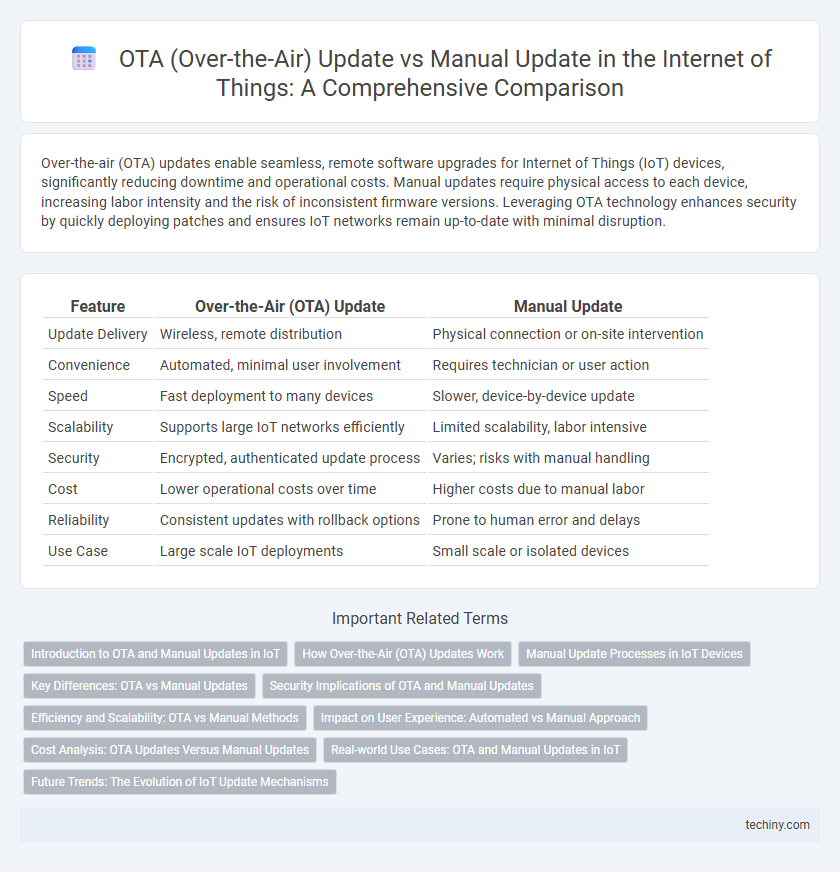Over-the-air (OTA) updates enable seamless, remote software upgrades for Internet of Things (IoT) devices, significantly reducing downtime and operational costs. Manual updates require physical access to each device, increasing labor intensity and the risk of inconsistent firmware versions. Leveraging OTA technology enhances security by quickly deploying patches and ensures IoT networks remain up-to-date with minimal disruption.
Table of Comparison
| Feature | Over-the-Air (OTA) Update | Manual Update |
|---|---|---|
| Update Delivery | Wireless, remote distribution | Physical connection or on-site intervention |
| Convenience | Automated, minimal user involvement | Requires technician or user action |
| Speed | Fast deployment to many devices | Slower, device-by-device update |
| Scalability | Supports large IoT networks efficiently | Limited scalability, labor intensive |
| Security | Encrypted, authenticated update process | Varies; risks with manual handling |
| Cost | Lower operational costs over time | Higher costs due to manual labor |
| Reliability | Consistent updates with rollback options | Prone to human error and delays |
| Use Case | Large scale IoT deployments | Small scale or isolated devices |
Introduction to OTA and Manual Updates in IoT
Over-the-air (OTA) updates enable remote deployment of firmware and software enhancements to IoT devices without physical intervention, ensuring timely security patches and feature improvements. Manual updates require onsite access for device reprogramming, often causing downtime and increased maintenance costs in large-scale IoT deployments. Leveraging OTA updates optimizes operational efficiency and minimizes disruptions across connected device networks.
How Over-the-Air (OTA) Updates Work
Over-the-air (OTA) updates deliver firmware and software enhancements wirelessly to Internet of Things (IoT) devices, leveraging secure communication protocols like HTTPS or MQTT to ensure data integrity and authenticity. These updates are managed remotely via centralized platforms that schedule, distribute, and monitor the installation process, minimizing downtime and reducing the need for physical device access. OTA updates enable real-time performance improvements, security patches, and feature rollouts, significantly enhancing operational efficiency compared to manual update methods that require device-by-device intervention.
Manual Update Processes in IoT Devices
Manual update processes in IoT devices require physical access to each unit, often involving USB connections or SD card installations, which can be time-consuming and prone to human error. This approach increases downtime and operational costs due to the need for on-site maintenance and delayed deployment of critical security patches. Unlike OTA updates that enable remote and automated firmware upgrades, manual updates limit scalability and pose challenges in managing large IoT deployments effectively.
Key Differences: OTA vs Manual Updates
Over-the-air (OTA) updates enable remote software upgrades for IoT devices via wireless communication, reducing downtime and eliminating the need for physical access, whereas manual updates require on-site intervention and device connection. OTA updates support scalability and timely patch deployment across large IoT networks, improving security and functionality without disrupting operations. Manual updates pose risks of inconsistencies and delays due to human error and logistical challenges, impacting device performance and maintenance efficiency.
Security Implications of OTA and Manual Updates
Over-the-air (OTA) updates significantly enhance IoT security by enabling timely deployment of patches and vulnerability fixes without physical device access, reducing exposure to cyber threats. In contrast, manual updates increase security risks due to the delay in patch application and potential human error during installation, leaving devices vulnerable. Secure OTA mechanisms, including encrypted communication and authentication protocols, are critical to prevent man-in-the-middle attacks and unauthorized firmware modifications in IoT ecosystems.
Efficiency and Scalability: OTA vs Manual Methods
Over-the-air (OTA) updates enable remote firmware upgrades, significantly enhancing efficiency by minimizing downtime and eliminating the need for physical device access across distributed IoT networks. Manual updates require individual device intervention, leading to scalability challenges due to time-intensive deployment and increased labor costs. OTA methods support seamless, large-scale rollouts, making them essential for managing extensive IoT ecosystems with diverse device types.
Impact on User Experience: Automated vs Manual Approach
Over-the-air (OTA) updates significantly enhance user experience by enabling seamless, automated firmware and software improvements without user intervention, reducing downtime and technical complexity. In contrast, manual updates often require users to initiate and manage the update process, leading to potential errors, extended device inactivity, and reduced accessibility for non-technical users. The automated OTA approach ensures timely security patches and feature enhancements, maintaining optimal device performance and user satisfaction across diverse Internet of Things (IoT) ecosystems.
Cost Analysis: OTA Updates Versus Manual Updates
OTA updates significantly reduce operational costs by eliminating the need for physical device retrieval and manual intervention, which can be labor-intensive and time-consuming. Manual updates incur higher expenses due to travel, on-site labor, and the risk of human error, increasing downtime and maintenance costs. Cost analysis reveals that OTA updates offer scalable, efficient, and remote firmware management, making them more cost-effective for large IoT device deployments.
Real-world Use Cases: OTA and Manual Updates in IoT
Over-the-air (OTA) updates enable seamless remote firmware upgrades for IoT devices like smart meters and connected vehicles, reducing downtime and operational costs. Manual updates remain critical in industrial environments with constrained network connectivity or high-security requirements, where direct physical intervention ensures controlled software deployment. Real-world implementations show OTA updates streamline maintenance for consumer IoT products, while manual updates provide essential fallback options in mission-critical systems.
Future Trends: The Evolution of IoT Update Mechanisms
Over-the-air (OTA) updates are rapidly becoming the standard for IoT device management due to their ability to deliver seamless, remote software enhancements, crucial for scaling IoT ecosystems. Future trends indicate increasing adoption of AI-driven OTA systems that enable predictive maintenance and autonomous security patches, minimizing downtime and operational costs. Manual updates will likely persist only in legacy systems or ultra-secure environments where physical access and control supersede convenience and efficiency.
Over-the-air (OTA) update vs Manual update Infographic

 techiny.com
techiny.com